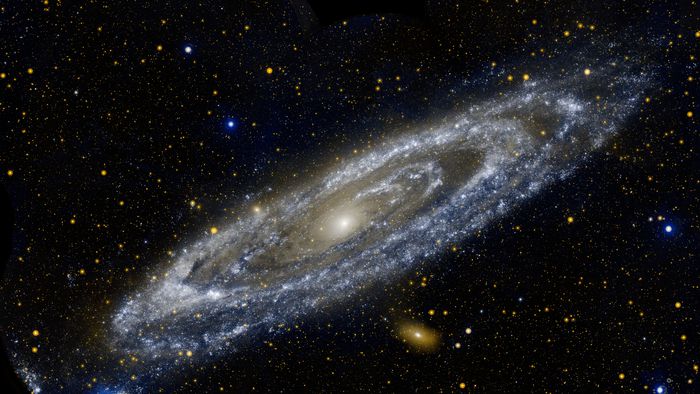Collision between black holes may have "stretched" Andromeda's galactic core

In the 1970s, astronomers used high-altitude balloons to observe the Andromeda Galaxy in uviolet light, and later the Hubble Space Telescope to supplement the data. They then discovered something unexpected: although it was a giant spiral galaxy like ours, the stars near the core were not the way they were supposed to. Now, decades later, a study can explain why.
- Two supernovas exploded at the same time and in the same place in this galaxy
- Astronomers found water in a galaxy 12.8 billion light years away
- Fluorine found in galaxy 12 billion light-years away surprises astronomers
The “problem” with the Andromeda center is that the orbits of stars are very unusually oval-shaped, and no one knew why. In the Milky Way, for example, stars orbit the central gravitational point — which is a supermassive black hole called Sagittarius A* — forming a circle that is not quite spherical but much less "stretched".
Such a shape was so strange that scientists gave it a name: "eccentric nuclear disk". The new study, led by the University of Colorado, suggests that a collision between two galaxies could explain this massive elongated core. Or rather, the collision between supermassive black holes in the cores of two galaxies that merged at some point in the past.
Large galaxies like the Milky Way and Andromeda grew up “devouring” smaller galaxies that were “feeding” around. This could also mean that the central supermassive black holes of these galaxies also collided—that is, if we don't put the final parsec problem into this equation, but we'll talk about it later.
–
Canaltech on Youtube: news, product reviews, tips, event coverage and much more! Subscribe to our YouTube channel , there's a new video for you every day!
–
The research authors wanted to know what kind of reaction the fusion of these black holes would cause in nearby stars. Through a computer simulation, they found that such a collision could release a devastating gravitational "kick," similar to a shotgun recoil, that hurls the merged black hole at breakneck speed. This probably pushed millions of stars into unstable orbits.
To arrive at this result, astronomers used as a basis calculations of the force generated by a fusion between supermassive black holes. First, the two objects begin to spin around each other, moving faster and faster in a spiral toward collision. When they collide, they release huge pulses of gravitational waves, literal ripples in the structure of space-time, as dictated by the theory of General Relativity .
It turns out that these waves, which travel at the speed of light in all directions, are anisotropic, according to the article. This means that they are not symmetrical, meaning they will have more strength or intensity on some sides and less on others. Therefore, the black hole resulting from the fusion will be hurled to the opposite side of the more powerful waves.
The next step was to figure out what this gravitational “slingshot” could do to stars within 1 parsec (3.26 light years or 206,000 astronomical units, or even 30.9 trillion kilometers) from the center of a galaxy. The result is a star “flying” in all directions, because the black hole would reach speeds that can reach millions of km/hour.
Since we're talking about a hole with a few million or billion solar masses, its gravitational field will affect the stars around it in an unpredictable and chaotic way, but in the end, the simulation showed something very similar to the stretched shape astronomers saw at the center. of Andromeda.
The authors know that the simulation is not definitive proof to validate this explanation, not least because they didn't use real data from the galaxy, but something they called a “toy” to try to “predict the orbital structure of a disk of stars after a kick in the central black hole”. Also, there's the final parsec issue , which doesn't seem to have been considered by the team.
The final parsec problem is a mathematical calculation that seems to suggest that central supermassive black holes in galaxies cannot collide when their host galaxies merge. Even if they get closer, there will come a time when they will lose kinetic energy and get no closer than 0.1 light-years to each other. To start spiraling toward a merger, they need to be 0.01 light-years away.
This problem isn't exactly a law that prevents astronomers from looking for supermassive black holes that formed by colliding galaxies. But it raises many questions that are difficult to answer. Anyway, the new article is a good starting point to solve the mystery of Andromeda's eccentric core. The team is already planning to improve the simulations so that the data are directly comparable to the real galaxy, which should require the inclusion of many more stars.
The results could also help scientists understand unusual events around other objects, such as planets around neutron stars. The research was published in The Astrophysical Journal Letters .
Read the article on Canaltech .
Trending at Canaltech:
- Solar explosion generates "cannibal cloud" that will hit Earth on this farm (4)
- Giant and rare owl makes its first public appearance in 150 years
- The best cell phones up to R$1,500 to buy on Black Friday
- What is the most used programming language in the world today?
- A mummy older than imagined could change the course of Egyptian history
Text source: CoinRevolution










